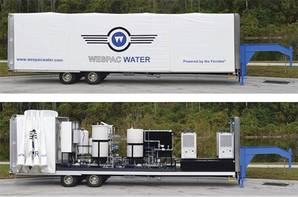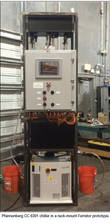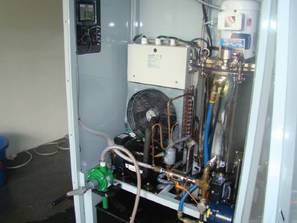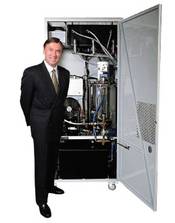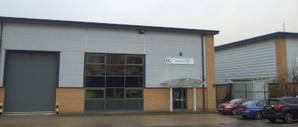Case Study
Custom chiller satisfies temperature control in chemical synthesis reactor.
Pfannenberg fits chiller into confined space within a packaged Ferrator® targeted for water and wastewater treatment in developing countries.
In their quest to develop an affordable Ferrate synthesis system, Ferrate Treatment Technologies, LLC of Orlando turned to Pfannenberg for help with developing a liquid cooling solution for a small, cabinet based system.
While already using Pfannenberg chillers for larger, trailer-based Ferrate synthesis systems, no standard packaged chiller was capable of integrating seamlessly within the concept of the self-contained cabinet based Ferrator system.
The treatment or “cleansing” of water takes on two primary requirements – eliminating contamination within acquired water prior to using or drinking (potable water); and eliminating contamination within used water prior to its release back to the environment (waste water). For both requirements, an element of cleansing involves disinfection which can be accomplished by several methods intended to kill, remove, or oxidise the contamination. Techniques include mechanical separation such as filtering and reverse osmosis; exposure to ultraviolet light and radiation; and the addition of chemicals such as chlorine or ozone, and now Ferrate. Each technique has its own advantages, disadvantages, effective cost ratio, and ability to scale up in order to treat the affected volume of water.
Oxidation is a process which causes chemical decomposition as well as breakdown of both organic and non-organic substances and is vital for the removal of contamination from water. As a chemical additive, Ferrate possesses extraordinary oxidation capabilities, however, it has historically been quite expensive to manufacture, which has limited its use primarily to laboratory research applications. Attempts to produce economical and commercially viable quantities of Ferrate had seen limited success until Ferrate Treatment Technologies, LLC of Orlando (FTT) changed the game by creating a streamlined synthesis process and point-of-use production device. By eliminating storage, handling, and transportation costs associated with a pre-packaged product, FTT has cut Ferrate deployment costs by more than 85 %.
Pfannenberg open-frame chiller inside packaged Ferrator. When FTT encountered problems with chillers from another manufacturer they contacted Pfannenberg to provide EB 150 chillers for skid-based systems. Due to their successful experience with Pfannenberg chillers for these applications, FTT turned to Pfannenberg once again for assistance with a project they had to fit a smaller scale Ferrator system into an enclosure. Initially, a CC 6301 packaged chiller was used successfully; however, new design criteria required further miniaturization and this standard packaged chiller would no longer fit. The Pfannenberg engineering team went to work on designing, building, and delivering and open frame chiller based on the CC 6301 that could fit within the confines of the small Ferrator enclosure.
Summary.
Water is a vital resource with an ever-increasing demand due to pressure from human expansion, activity, and population increase. Clean water is a necessity for both human health and environmental sustainability. With a limited supply to that found on earth, man must utilize and develop ways to protect and ensure the availability of clean water.
Newer technologies involving reverse osmosis for desalination will increase the fresh water supply derived from the seas while improvements in disinfection technologies will be vital for recycling and conservation of rainfall-dependent fresh water derived from lakes, rivers, and wells. Automated controls, pumps, and chemical reactions utilized in these efforts can all be protected by products from Pfannenberg.
| Description | Language | Type | Size | Download |
|---|---|---|---|---|
Case Study Ferrate Treatment |
|
3.1 MB | Download |
